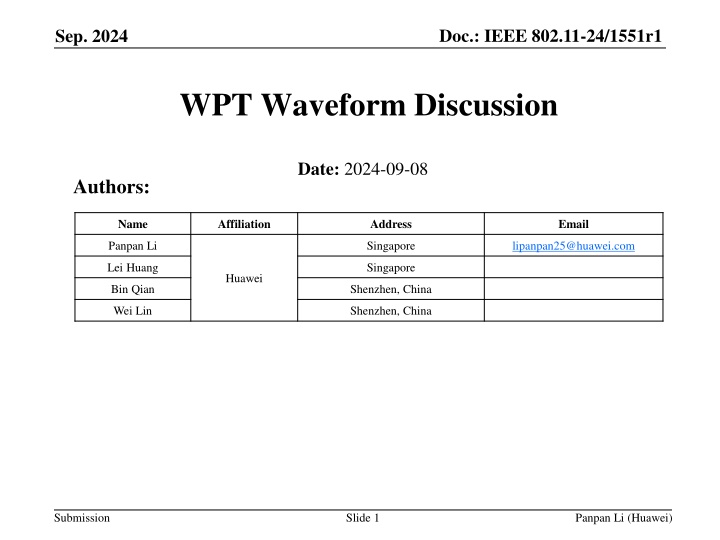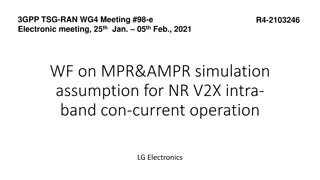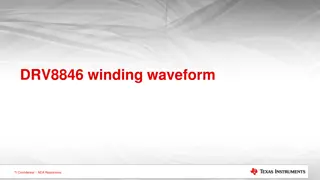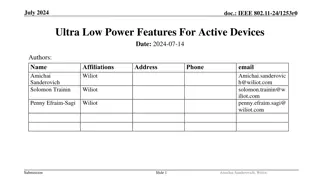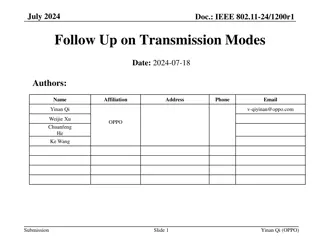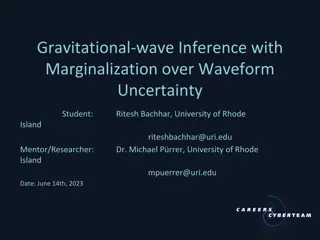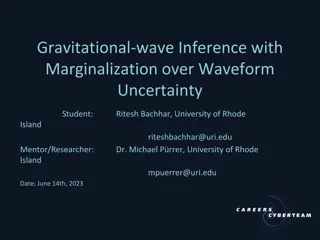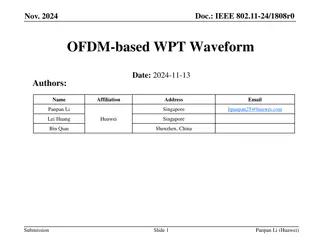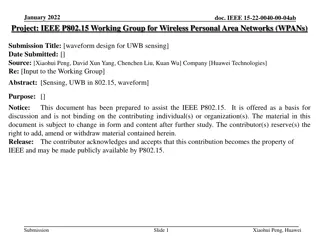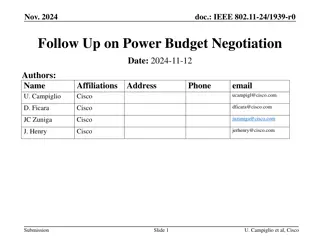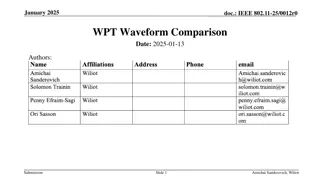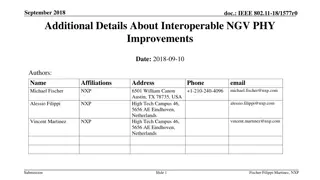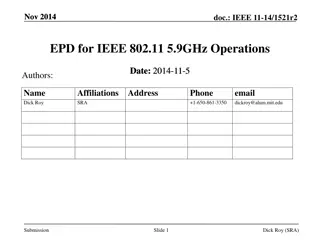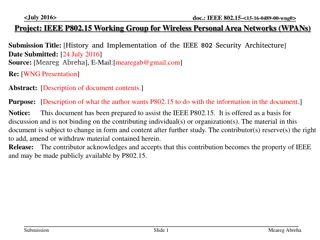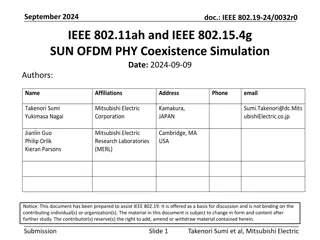Standardizing WPT Waveform in IEEE 802.11-24/1551r1
This contribution discusses the standardization of Wireless Power Transfer (WPT) waveform in IEEE 802.11-24/1551r1, emphasizing the benefits, requirements, and potential implications. The document explores the necessity for standardized waveforms, summarizes key discussions, and addresses the efficiency and regulatory aspects of WPT waveform design.
Download Presentation

Please find below an Image/Link to download the presentation.
The content on the website is provided AS IS for your information and personal use only. It may not be sold, licensed, or shared on other websites without obtaining consent from the author.If you encounter any issues during the download, it is possible that the publisher has removed the file from their server.
You are allowed to download the files provided on this website for personal or commercial use, subject to the condition that they are used lawfully. All files are the property of their respective owners.
The content on the website is provided AS IS for your information and personal use only. It may not be sold, licensed, or shared on other websites without obtaining consent from the author.
E N D
Presentation Transcript
Doc.: IEEE 802.11-24/1551r1 Sep. 2024 WPT Waveform Discussion Date: 2024-09-08 Authors: Name Affiliation Address Email Panpan Li Singapore lipanpan25@huawei.com Lei Huang Singapore Huawei Bin Qian Shenzhen, China Wei Lin Shenzhen, China Submission Slide 1 Panpan Li (Huawei)
Doc.: IEEE 802.11-24/1551r1 Sep. 2024 Abstract This contribution intends to trigger the discussion of WPT waveform: Shall WPT waveform be standardized ? Requirements of WPT waveform Potential WPT waveform Submission Slide 2 Panpan Li (Huawei)
Doc.: IEEE 802.11-24/1551r1 Sep. 2024 Background 11bp PAR [1]: at least one mode of wireless power transfer in the sub-1 GHz band is defined to support RF energy harvesting [2] make following WPT waveform recommendation: WPT protocols are discussed in [3]. AMP devices may be treated as RFID devices from a frequency regulation perspective [4]. [1] 11-24-0575-01-0amp-p802-11bp-par. [2] 11-24-1200-00-00bp-follow-up-on-transmission-modes. [3] 11-24-1208-00-00bp-thoughts-on-the-amp-wpt-protocol. [4] 11-24-0900-00-00bp-wireless-power-transfer-and-frequency-regulation Submission Slide 3 Panpan Li (Huawei)
Doc.: IEEE 802.11-24/1551r1 Sep. 2024 Shall WPT waveform be standardized ? Benefits of standardizing WPT waveform in 11bp Enhanced power transfer efficiency Standardized waveform ensure that the transmitted signal is optimized for minimal losses. This optimization helps in focusing energy within the designated frequency band, improving the efficiency of power transfer. Minimized interference By adhering to a consistent waveform profile, the system's emissions can be better controlled, reducing the risk of interference with nearby devices and improving overall system performance. Optimized system design and implementation Standardized waveform streamline the design process by providing a common reference for optimizing transmitter and receiver circuitry. This reduces design complexity and enhances system performance. We prefer 11bp shall specify WPT waveform. Whether this specified WPT waveform is mandatory/optional is open for discussion. Submission Slide 4 Panpan Li (Huawei)
Doc.: IEEE 802.11-24/1551r1 Sep. 2024 Requirements of WPT Waveform Follow regulations Some regional regulations are given in Appendix A High RF-to-DC conversion efficiency Various papers [5, 6] show that waveforms with high peak to average power ratio (PAPR) increase RF-to-DC conversion efficiency of the rectifiers. What other waveform property may affect conversion efficiency ? [5] B. Clerckx and E. Bayguzina, "Waveform Design for Wireless Power Transfer," in IEEE Transactions on Signal Processing, vol. 64, no. 23, pp. 6313-6328, 1 Dec.1, 2016. [6] A. Collado and A. Georgiadis, "Optimal Waveforms for Efficient Wireless Power Transmission," in IEEE Microwave and Wireless Components Letters, vol. 24, no. 5, pp. 354-356, May 2014. Submission Slide 5 Panpan Li (Huawei)
Doc.: IEEE 802.11-24/1551r1 Sep. 2024 Potential WPT Waveform We prefer DSSS-based (11b like) or OFDM-based WPT waveforms, which can be generated with current WiFi systems. DSSS-based (11b like) WPT waveforms OFDM-based WPT waveforms Bandwidth Dependent on chip rate Can utilize bandwidth flexibly by adjusting number of subcarriers TX power May be able to achieve high power transmission compared to single-tone waveform PSD May violate PSD masks because of high side lobe PAPR 1 May achieve higher PAPR because of multi carrier aggregation RF-to-DC conversion Efficiency What other waveform property may affect conversion efficiency ? Submission Slide 6 Panpan Li (Huawei)
Doc.: IEEE 802.11-24/1551r1 Sep. 2024 Summary This contribution intends to trigger the discussion of WPT waveform We prefer 11bp shall specify WPT waveform. WPT waveform are expected to follow regulations and achieve high RF- to-DC efficiency. We prefer DSSS-like or OFDM-based WPT waveform, which can be generated with current WiFi systems. Submission Slide 7 Panpan Li (Huawei)
Doc.: IEEE 802.11-24/1551r1 Sep. 2024 SP 1 (For information collection, not for SFD) Do you agree that 11bp shall specify WPT PPDU/waveform? Whether this specified WPT waveform is mandatory/recommended is TBD. Yes No Abstain Submission Slide 8 Panpan Li (Huawei)
Doc.: IEEE 802.11-24/1551r1 Sep. 2024 Appendix A Except the table below, other regulations [iv] may also be considered. China [i] Europe [ii] US [iii] RFID RFID Frequency hopping spread spectrum Digital modulated systems Bands (MHz) 840-845, 920-925 865-868 915-921 902-928 Bandwidth 250 kHz 200 kHz 400 kHz TX power 2W (ERP) 2W (ERP) 4W (ERP) >=50 channel: 36 dBm (EIRP) <50 channel: 30 dBm (EIRP) 36 dBm (EIRP); <=8 dBm in any 3 kHz Transmit mask Adjacent Channel Power Ratio (ACPR): 40dB (first adjacent channel), 60 dB (second adjacent channel) Channel<250kHz, at least 50 channels; Channel>250kHz, at least 25 channels; Maximum allowed 20dB bandwidth is 500kHz minimum 6 dB bandwidth shall be at least 500 kHz [i] 800/900MHz RFID . [ii] https://www.etsi.org/deliver/etsi_en/302200_302299/302208/03.04.01_60/en_302208v030401p.pdf. [iii] https://www.law.cornell.edu/cfr/text/47/15.247. [iv] https://www.itu.int/dms_pubrec/itu-r/rec/sm/R-REC-SM.2151-0-202209-I!!PDF-E.pdf Submission Slide 9 Panpan Li (Huawei)
